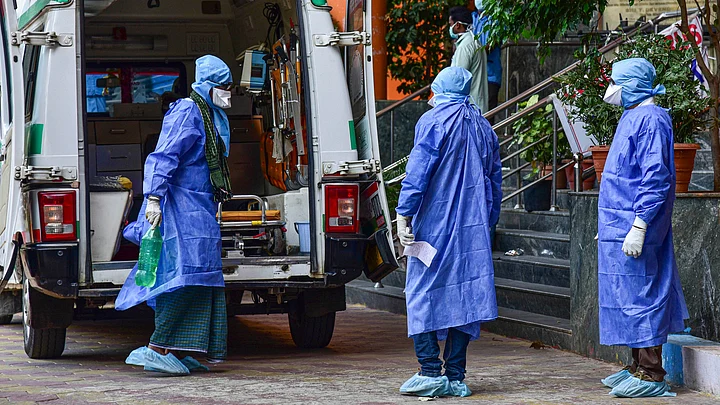The sharp spike in COVID-19 cases and deaths are the new realities for the people of Karnataka. The measures needed to contain the virus have been heavily debated, with experts suggesting multiple solutions. However, an analysis of the data on COVID-19 deaths in Karnataka provides insights that could suggest key areas of improvement.
The Quint analysed the 1,394 deaths reported in Karnataka until 20 July to recognise and understand patterns in these deaths. We contacted experts to explain these patterns, and to understand their implications in the fight against the coronavirus.
How Deaths Spiked In Karnataka
Number of Days Spent in Hospital
In 11 percent of the COVID-19 deaths that Karnataka has seen, patients were not in a hospital at the time of death. Also, for the 1,227 hospitalised patients, who later died, the average number of days spent in a hospital is around three days.
Dr V Ravi, the head of Neurovirology at the National Institute of Mental Health and Neurosciences (Nimhans), interpreted this data as a sign of late detection and reporting of COVID-19 symptoms.

“When patients come with acute respiratory distress, there not much that can be done medically. So, it is important that they came at a stage when they are in a situation where they don’t require ventilator support,” he said.
The data on the discharged patients shows that between the date of admission to hospital and discharge, a recovered patient spent around 11 days in the hospital. This reaffirms that early hospitalisation helps in saving lives.
Why The Delay In Hospitalisation?
According to experts, delay in getting treatment is a combination of two factors - people not taking mild symptoms seriously and a failure by the healthcare system to identify and isolate vulnerable people.
The answer to the first part is simple. There should be far greater public awareness about taking symptoms seriously, along with an effort to remove the stigma connected to being identified as COVID positive.
To address the second problem, we need to examine if the healthcare system is prepared enough. A senior doctor, working closely with the government, on condition of anonymity, explained where the state is currently lacking on this front.
“If you ask me, can we do it (identify vulnerable people), yes we can. But are we doing it? It's a complicated answer. The problem is that the urban areas in the state lack workforce in the healthcare sector, in fact it is too skeletal, to effectively implement this,” the expert said.
Urban Healthcare Needs More Manpower
Giving a comparison, the expert said that in rural areas, for a population of approximately 30,000, there is at least one primary healthcare centre and each primary health care centre has four to five health workers conducting outreach programmes.
That is one healthcare worker for every 5,000 people.
Similarly, on average, every 1000 people have one ASHA worker. This enables better contact tracing, detection and isolation.

But in Bangalore, for 198 wards, there are only 135 health centres, which translates to one health centre per 90,000 people. Naturally then, the number of health outreach workers and ASHA workers are also fewer.
“Initially, when the number was low, they managed with the existing workforce. But now, with thousands of cases, they are unable to track, trace and isolate the vulnerable. The government should have anticipated this and added more health workers to the system,” the expert said.
The doctor also added that there should be separate action plans for rural and urban areas.
Understanding Co-Morbidities
72.8 percent on all CIVID-19 deaths in Karnataka have been among people over the age of 50 years. The highest number of deaths are in the 51-60 age bracket, with 407 reported cases. The average age of those who have died is 58 years, while the average age of those discharged is 34 years.
But does it mean that the young are less vulnerable to the virus? In that context, a closer look at the co-morbidities in the deceased is needed.
Diabetes Mellitus, Hypertension and Ischemic heart disease are the common co-morbidities associated with COVID-19 deaths in Karnataka.
There is a perception that those with lung-related ailments are more vulnerable to COVID-19. However, the data shows a different reality. Diabetes mellitus is the most common primary co-morbidity among COVID-19 deaths in the state.
A breakup of all reported co-morbidities shows that 43.9 percent of victims had diabetes, 42.3 percent of deceased had hypertension, and 14 percent of cases had a history of Ischemic heart disease.

In many cases, patients showed a combination of multiple co-morbidities. Data shows 7 percent of COVID-19 deaths had all the three co-morbidities mentioned above, and 30 percent had both, diabetes and hypertension.
Lessons From the Data
According to epidemiologist Dr Giridhar Babu, a professor at the Public Health Foundation of India, this shows that just because more deaths are reported amongst the elderly, the young should not take it easy.
“There is a higher chance of COVID-19 situation affecting patients severely if they are suffering from these co-morbidities. So, anyone who has these common co-morbidities, regardless of age, should take additional precautions,” he added.
So, what should you be careful about? The data shows that the most common symptom is breathlessness. A combination of breathlessness with fever, cough, body pain, cold or any other symptoms of COVID-19, should not be taken lightly.
For the common man, the biggest lesson from the deaths in Karnataka is to not take any symptoms lightly and get help at the earliest. For the government, the lessons are - create a larger workforce to identify the vulnerable, monitor them, and get them medical care at the earliest.
(At The Quint, we question everything. Play an active role in shaping our journalism by becoming a member today.)
